People have seen significant impacts of technology in their day-to-day life in the past two years. They have seen innovative solutions brought around through digital transformation for shopping, analyzing, working, entertaining, or even creating art at their fingertips.
Information today is processed at lightning speed to build new business strategies for attracting them. Penetration of technologies like AI/ML in normal people’s life has in term gave birth to a host of new use cases and business opportunities.
Digital Transformation Trends Across Industries
In 2023 we will see the efforts of digital transformation technologies revolve around bettering the services from these new technologies and creating unique products. Listed below are a few of the digital transformation trends which will shape the technology ecosystem.
Digital Healthcare Will Extend To “Non” Patient
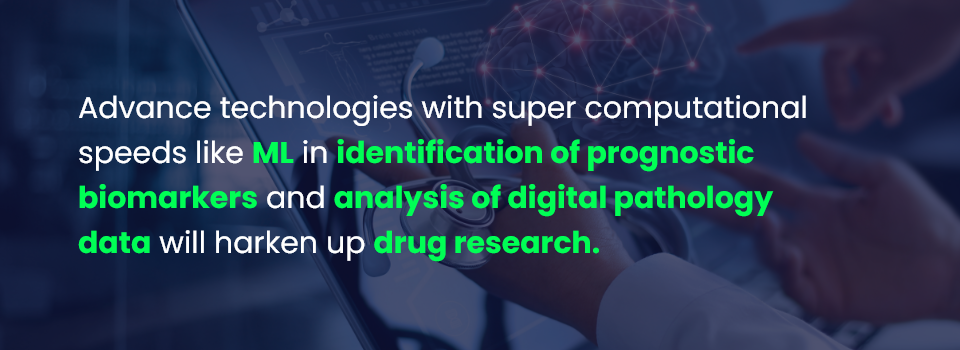
The extensive adoption of digital technologies has transformed the treatment method quite rapidly in the past few years. However, a lot of transformation is yet to be achieved in terms of health promotion, disease prevention, rehabilitation, drug research, and other aspects of healthcare.
We will see a rising awareness towards self-care with the growing popularity of wearable techs.
Analytics-driven insights, grouped by demographics, ethnicity, age, and likely parameters on a particular disease can contribute to arresting the spread of disease and prevent a pandemic-like fallout.
Advanced technologies with super computational speeds like ML in the identification of prognostic biomarkers and analysis of digital pathology data will harken up drug research.
We will also witness automation replacing most of the repetitive tasks in a hospital setup like booking appointments, checking inventory, and maintaining in-house patient occupancy logs.
Hiring Will Become Data Intensive
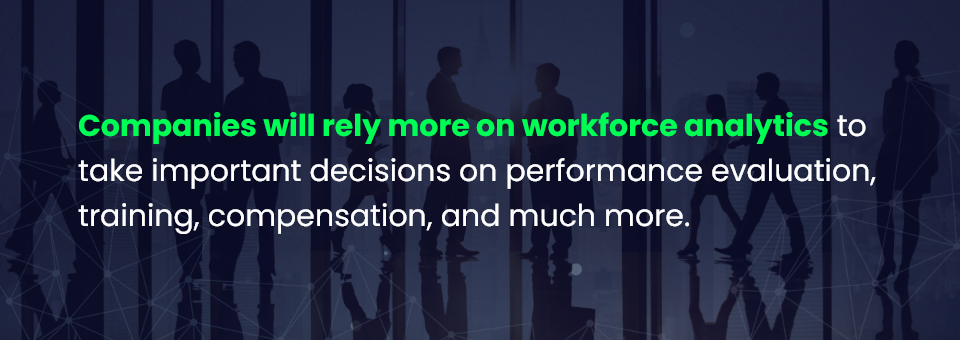
Data handling capacities of enterprises are increasing and 2023 will see the application of analytics to recruitment and workforce management processes for optimum utilization of resources. Companies will rely more on workforce analytics to take important decisions on performance evaluation, training, compensation, and much more.
Employees seek opportunities to hone their skills and people analytics, a branch of workforce analytics can help understand if they are satisfied with the role or will be able to serve more effectively in some other role. People Analytics can be used to measure important metrics like burnout rate and plan work hours accordingly to increase retention rate.
Insights will also help in creating a balanced workforce for every project identifying the strength and weaknesses of individual members. Data will also point out the skill level of employees and the requirement for training.
AI Will Closely Study Human Biases
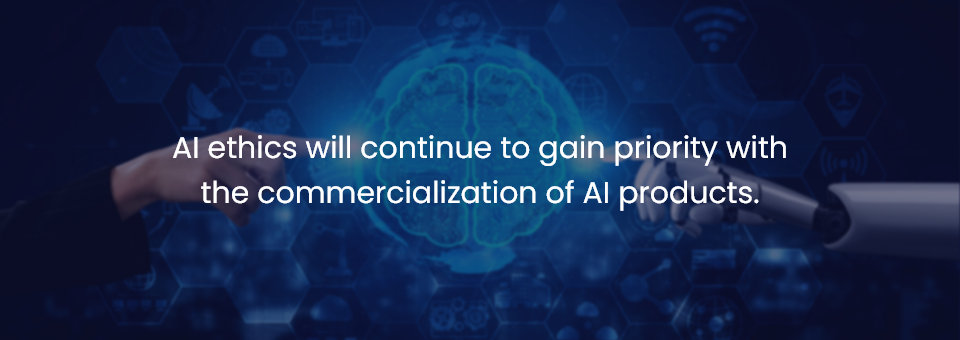
“Bias in AI” has become a familiar topic among the data science community as common people get more and more accustomed to AI-generated text and images. AI is not trained out of thin air but with algorithms developed by real people and datasets from the real world which may be tainted with biases regarding race, gender, biological sex, age, and culture. So often we find an AI engine has run into some controversy after generating some apparently biased content.
AI ethics will continue to gain priority with the commercialization of AI products. We will see extensive attempts in making AI anti-bias and for that, we will see AI trying to closely study or mimic human anti-biases. AI will attempt to evaluate the consistency of decision making. “Democratization of AI” has made it very important for AI to be culturally sound enough to maintain equality and fairness.
We have seen a couple of bias detection algorithms and toolkits like IBM’s AI Fairness 360 toolkit, Microsoft’s Fairlearn, and Amazon’s Sagemaker already available in the market, and can expect more to be launched in 2023.
Specialization of Data Scientist Roles
Until now we have seen the data scientist role is trained as a generalist role of coding, algorithm development, and analytics. One of the reasons being newly adopting enterprises is often confused to distinguish this evolving role from that of a data analyst or business analyst.
However, there is a dearth of data scientists with industry-specific knowledge who can find solutions to real-world business problems. Industry trends indicate that specialization as a data scientist in certain domains like AI, ML, or Database Management can actually increase the employability of a profile.
Companies have started to look beyond the generic data scientist roles and prefer to hire specialist profiles like Data Engineer, Machine Learning Engineer, Algorithms Developer, Big Data Engineer, and DevOps Engineer.
AI Impacts Industrial Operations
Implementation of AI solutions to core industrial processes will continue to see a rise in 2023. AI-driven visual inspections for quality checking of products or machine inspection will become the norm.
We will also see an implementation of AI to maintain environmental norms in the manufacturing industry. For example, AI can identify the equipment responsible for excess energy consumption and emissions. It can also help in setting the optimal process parameters or production sequence to minimize emissions.
IoT technologies are already influencing core sectors and are capable of generating large amounts of data which also sometimes happens to be unique. AI engines integrated with IoT sensors are capable of processing huge volumes of data and will bring out some new information.
Increased Demands For Synthetic Data
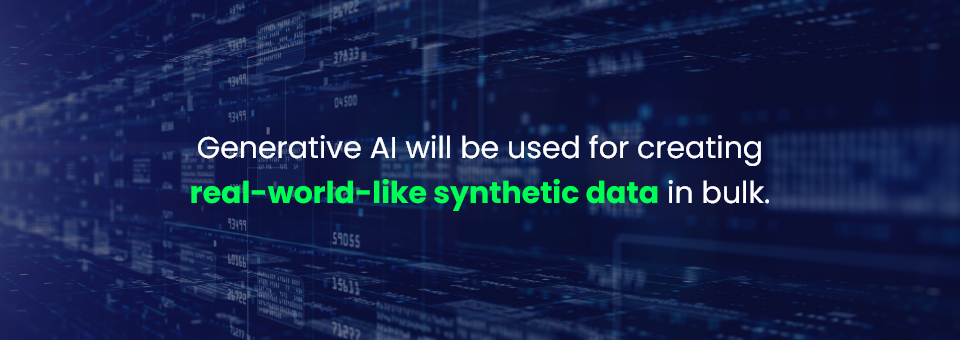
AI/ML research requires tons of training data but with increased data privacy regulations being enacted by various governments it is becoming more and more difficult to get hands on real-world data. This has created a market for synthetic data.
In 2023, we will witness a rise in data generation services from commercial vendors. Organizations looking to monetize intellectual property data will join the data supply chain. Generative AI will be used for creating real-world-like synthetic data in bulk. By making data affordable and accessible we can expect to witness some economic benefits in terms of AI/ML research.
Organizations Move From Data Warehouse To Real-Time Data Storage
More and more organizations will be transitioning from legacy data warehouses to cloud based real-time data storage systems. Data is the new fuel to drive business decisions.
Organizations expect to be able to access and utilize their data in real-time.
Whether a manufacturer monitors IoT streaming data from the assembly line, or a pharma lab sifting through huge datasets, the ability to respond in real -time is crucial to their operation.
Most cloud-based data storage systems apply ETL or ELT to clean and process data before storing, making them ready for immediate consumption.
Additionally, cloud-based real-time data storage systems offer scalability which helps companies to pay as they grow instead of blocking the budget on a fixed asset beforehand.
Digital Twin Technologies Create Significant Impacts
Digital Twin Technologies are rising in popularity where a digital replica of a real physical object is created. It can be used to perform simulations of real world situations and collect data to predict how a product would perform.
2023 turning out to be a year of recession, business owners would like to go the MVP mode. Testing and validating their ideas of a physically asset-heavy project with a digital twin will become a preferred way to go.
We will also see the application of digital twin technologies in improvising real-world business processes like modeling the flow of people in retail stores and hospitals.
Unstructured Data To Give New Directions To Healthcare Research
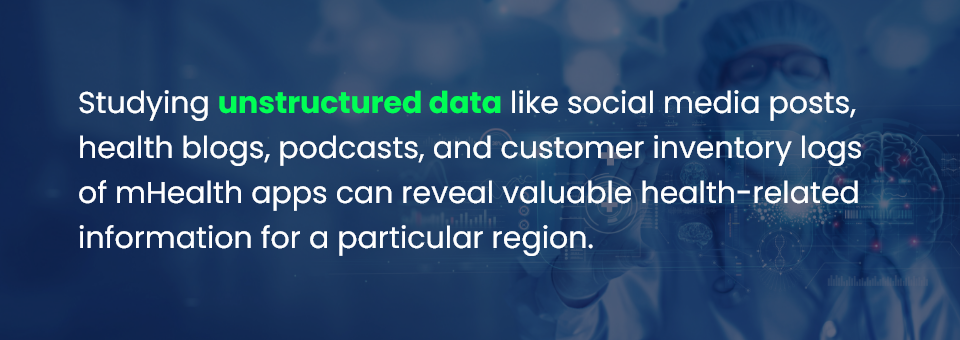
EHR, insurance contracts, digital reports from wearables, handwritten prescriptions, pathology reports, etc.; healthcare witnesses the generation of millions of data in diverse formats every day. It used to be a tedious task to convert these unstructured data to a single format manually so that they can be easily consumed for analytics and Data Science related research.
However, the advent of AI and NLP models is changing this. Supercomputing capacities let huge amounts of data get easily converted to a retrievable format in a very short period of time.
Studying unstructured data like social media posts, health blogs, podcasts, and customer inventory logs of mHealth apps can reveal valuable health-related information for a particular region. We may see insurance companies studying the financial status, and medical bills of prospective clients to create income-specific health insurance plans.
Digitizing handwritten notes using NLP will increase to form one single repository of medical information for a patient.
Adoption of NLP tools in documentation of medical information will also encourage medical practitioners to interactively contribute who are otherwise not very keen on learning new tools and software.
“Analytics For Everyone” Becomes Crucial For Businesses
2023 will see businesses making more analytics-driven decisions. ‘Analytics for everyone, everywhere’ is going to be a major trend as the growing adoption of machine learning, artificial intelligence, computer vision, and IoT creates a flow of data across the industry.
The ‘democratization of analytics’ through self-serviced models will continue to be the ulterior motive for which data practitioners strive. We will see some kind of access to analytics tools for people with no coding skills through emerging low-code/no-code tools.
We also expect the intrusion of language model applications like Chat GPT into the analytics space to carry out simple analytics processes from simple human language instructions.
Most large businesses today use more than one BI tool and we will see the increased use of composable analytics tools. Businesses will also integrate AI with analytics to get new information from unstructured data.
Embedded Fintech Will Gain More Importance
Integration of fintech features and services like identity theft protection, data breach protection, subscription management, and bill negotiation services will become preferred as an add-on to regular banking services.
As platforms like Amazon, Square, and Shopify target small business customers with their financial services small banks will need to build counter strategy using embedded fintech strategy.
We will also see an increased investment in AI chatbots by financial institutions as Generative AI is the coolest technology right now and banks can’t help but match up with the expectations of Gen Z users.
More Blockchain-based Online Games
We will see blockchain technology becoming a supporting technology in the eSports or online games ecosystem. Players today get a small percentage of the industry revenue. Investment in eSports is also a bit complicated and often unsecured.
Blockchain will create decentralized platforms for eSports helping industry stakeholders to connect. Transparency of blockchain will encourage players to invest their time, skill, and money for a fair share of the profit.
Game developers will also have secured work contracts using blockchain. Blockchain will also lower the cost of maintaining and operating a secure platform and level the playing field for investors. We will also see the facilitation of in-app purchases and trading of rare in-game assets.
State-of-the-art Technologies Driven By Specialist Roles Will Influence Digital Transformation In 2023
Above are the trends which will dominate the 2023 digital transformation. Organizations can ramp up their preparation in the respective domains they are working on or find a suitable partner to help them out. For example, realizing if they need an experienced AI partner or adopting a SaaS solution will help them set a structured budget plan.
